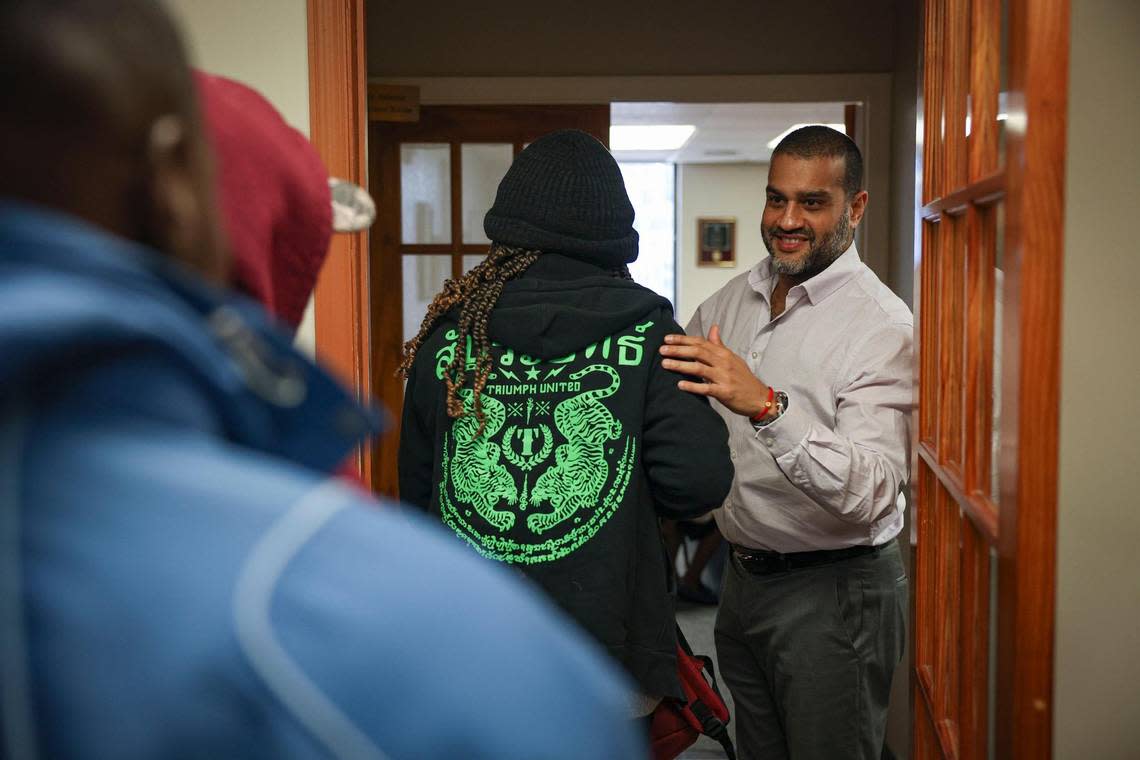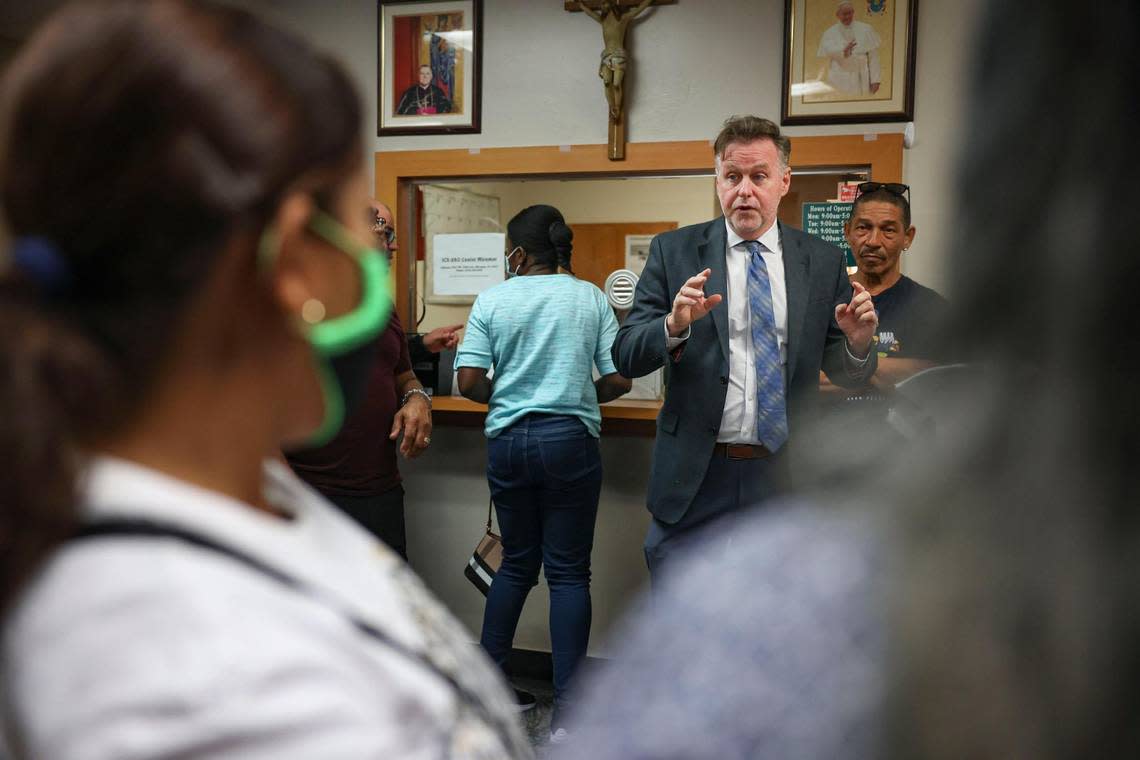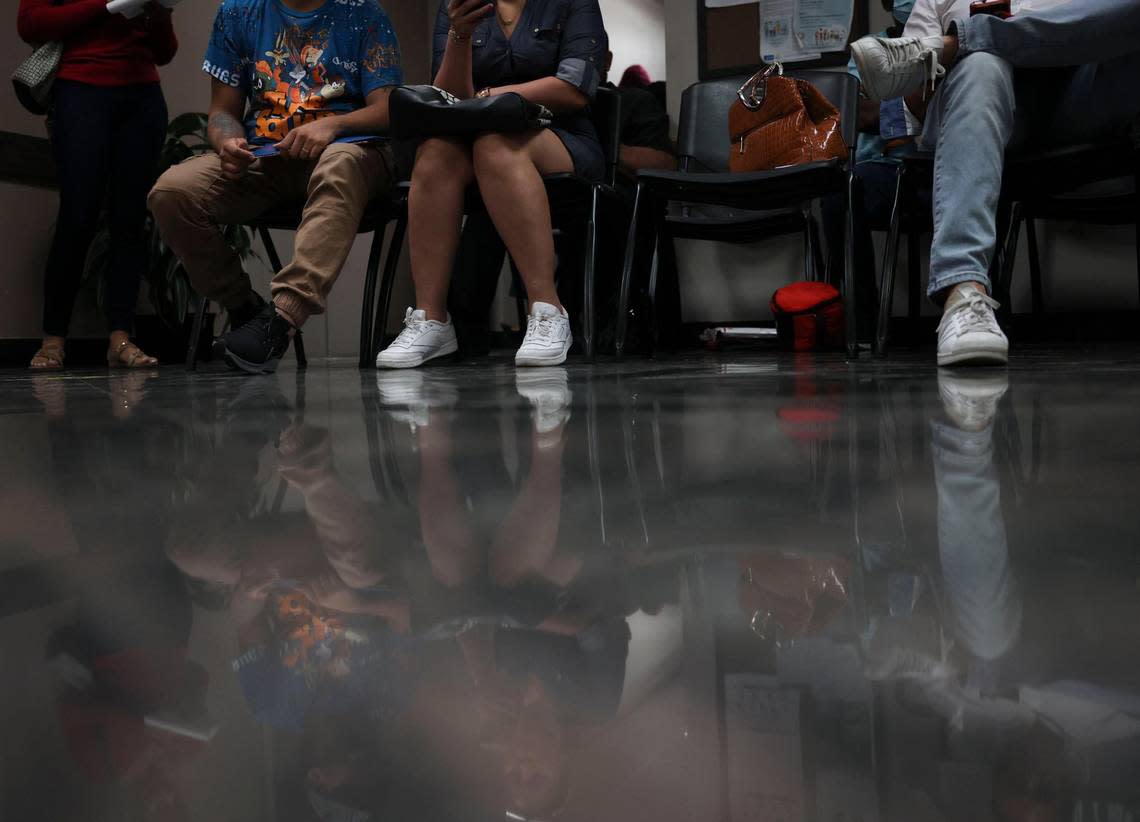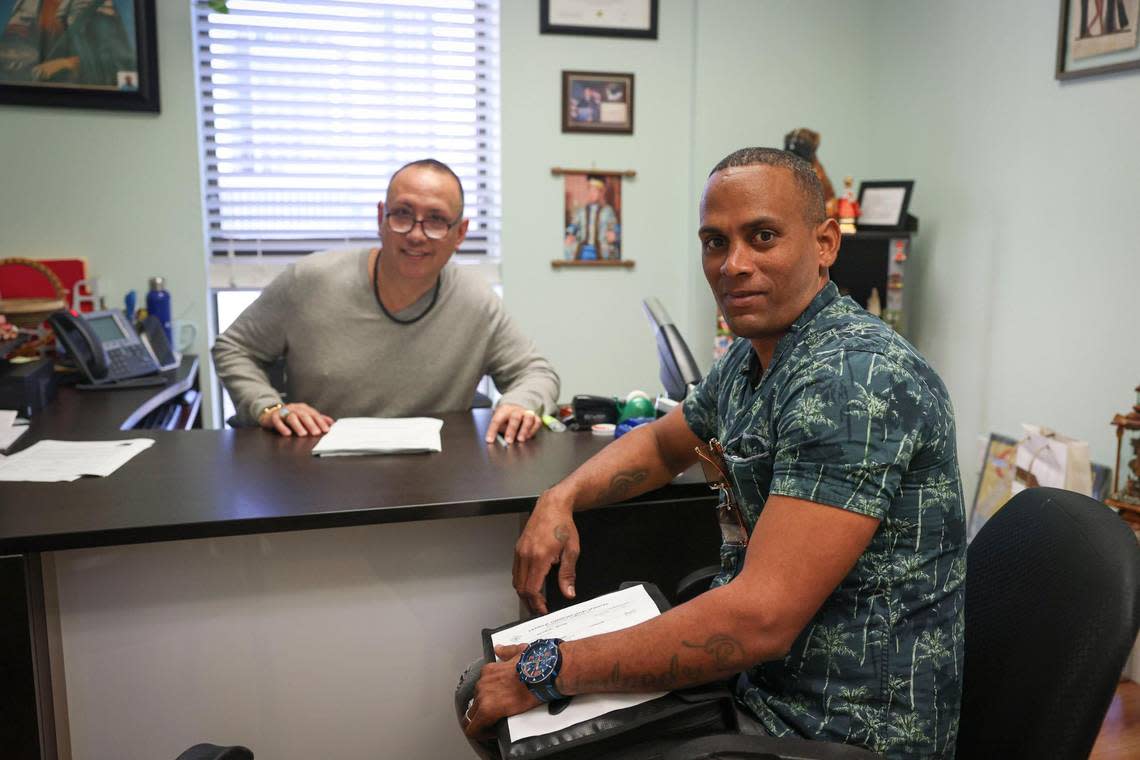This Miami agency has been helping migrants for decades. These days, it’s busier than ever
On a recent day, migrants from all over the world rush in and out of a small reception room in a small suite of offices in downtown Miami.
One woman brings her nephew, who arrived from Nicaragua in December, to ask a lawyer questions about his month-long parole. A couple from Cuba — a pizza maker and a hairstylist — whose passports were soaked when they crossed the Rio Grande in Texas with their 13-year-old son have come for their work permit applications. Another couple who want to marry — a Peruvian woman who came as a tourist five months ago and a longtime Miami resident from Cuba who fell head over heels — seek advice about their case.
The people walking through the doors of Catholic Legal Services on any given day are a microcosm of Miami’s immigrant fabric and the challenges facing new arrivals and those who help them: Cubans who arrived on makeshift boats as conditions on the island deteriorate, Haitians fleeing kidnapping gangs, Venezuelans seeking better economic conditions, and Nicaraguans escaping government repression.
As an unusually large wave of migrants continue to seek entry into the United States, many through the country’s southern border with Mexico and most recently through the Florida Straits in makeshift rafts and leaky boats, many have landed in Miami. And they are turning for help to the agency, which offers low-cost and free legal services to migrants.

The number of people who want help “is so large that we could not individually represent all the people who need” it, said Randolph McGrorty, co-founder and executive director of Catholic Legal Services. On a recent Monday, more than 100 people were seeking help.
Following the peak of the COVID-19 pandemic and with the increase in new arrivals, McGrorty said the agency is seeing about 3,000 people a month. They help them fight deportation orders, apply for naturalization, win asylum cases, secure work permits and other immigration needs.
READ MORE: Homeless chief takes ‘hard line’ on shelter for migrants
The demand for services has coincided with the saturation of South Florida’s informal network of friends, family, and neighbors who take in the newly arrived migrants. It also comes as food and housing prices have risen, burdening both longtime residents and those seeking to resettle here. And the agency — which celebrated its 25th anniversary this month — is trying to adapt to help as many people as it can.
“Our mission is to help people who come from other countries and can’t afford private attorneys. We’re going to continue to do that,” McGrorty said. “More and more people obviously need our services, and we will do what we can to help them.”
The organization has remained anchored in the Roman Catholic Church’s long legacy of helping Miami’s immigrants in need, which spans as far back as the early 1960s, when the church helped thousands of unaccompanied children who came from Cuba as part of the Pedro Pan program.
A decade later, Catholic priests joined with local Black leaders to welcome the first documented arrival of Haitians by boat to South Florida. Now it’s Venezuelans, as well as the latest wave of Cuban rafters, who after being released are often directed to the agency by immigration officials and community members.
“In the Catholic Church there are no borders,” said Miami Archbishop Thomas Wenski, who spent his first 18 years as a priest ministering to newly arrived Haitians at Notre Dame d’Haiti Mission in Little Haiti. “When you go back to the Scriptures, you have Moses taking the people out of slavery from Egypt, you have Mary and Joseph taking baby Jesus to Egypt because Herod wanted to kill him. That’s a classic refugee story right there.”
Little Haiti roots
The origins of Catholic Legal Services are rooted in a legal project based out of the Notre Dame d’Haiti Mission, which began offering legal services to Haitians in 1994. Four years later, the group united forces with the Catholic Legal Immigration Network in Miami, and formally became Catholic Legal Services in January of 1998.

Today the nonprofit has about 60 lawyers and staffers who speak Spanish, English, Creole and more. It is funded through a mix of sources, including grants and donations from the federal government, private donors and sometimes clients themselves.
The group’s clientele is a mirror of Miami. Most come from Haiti, Cuba, and Venezuela, followed by Honduras, Nicaragua, Colombia, and Guatemala, among other countries. In all, they come from more than 120 different nations and territories, according to the most recent yearly report.
Weekly off-site clinics, aimed at helping migrants navigate the U.S. immigration system, understand their rights and apply for Temporary Protected Status, take place in community hubs like the Joseph Caleb Center in Liberty City and Notre Dame d’Haiti Catholic Church in Miami. The agency helped Haitians and Venezuelans complete more than 1,000 applications for the immigration protections in 2021.
“The work that these lawyers and staff do is really life-changing for so many people,” said Wenski. “To solve a case by getting someone permanent residency, or Temporary Protected Status, or a work permit, it opens hope for them.”
Catholic Charities, another social services organization under the Archdiocese that offers resettlement services as well as shelter for unaccompanied children, is often another first stop for migrants coming to Miami.
‘The joy in their faces’
In the reception room of Catholic Legal Services, Spanish and Creole fill the air as a newscaster drones on the television. The walls are plastered with posters of parenting classes, where to get COVID-19 vaccinations and how to apply for government benefits. A crucifix and an image of the Virgin Mary watch over visitors.
Daniella Charles-Leroy, the administrative assistant manning the front desk, knows what it’s like to be on the other side of the waiting room. She arrived from her native Port-au-Prince less than two years ago. Catholic Legal Services helped her obtain Temporary Protected Status. Now, with her permanent residence pending, she gets to help people in similar situations.
“When I tell them, you are going to see a lawyer, or apply for a work permit, you can see their smiles, the joy in their faces,” said Charles-Leroy, who speaks English, Spanish, Creole and French.
Emilio Garcia, a paralegal licensed by the federal government to represent immigrants, welcomes clients into his office, an image of the Virgin of Charity, Cuba’s patron saint, pinned to his door.

Nolberto Ramos, a 46-year-old radiologist from the eastern Cuban province of Granma, is among Garcia’s first clients of the day. In November 2021, three months after arriving in the western Venezuela province of Merida, Ramos deserted the Cuban medical mission that had sent him there. He fled towards the state of Apure, on the Venezuela-Colombia border, hoping the whole way that no Cuban or Venezuelan authorities would find him.
After spending a month in Apure, where he had previously lived between 2017 and 2019 on a separate medical mission, he embarked on a nearly three-day journey through the Darien Gap, the treacherous mountainous patch that connects Colombia and Panama.
In January 2022, after traveling through Costa Rica, Nicaragua, Honduras, Guatemala and Mexico, he crossed the border into Arizona. He relocated to Nebraska for two months, where the brother of his former girlfriend in Cuba lived. He came to Miami in April. He is living in an apartment with his cousin and wife and receives monthly cash assistance, food stamps, and Medicaid.
On Thursday, he and Garcia worked on his asylum application. In a few months, Garcia will help Ramos apply for a work permit.
“It’s after deserting that I have felt threatened. They have jailed some of us,” said Ramos, referring to doctors that Cuban authorities have detained after attempting to flee a medical mission.
Said Garcia: “He can’t go back to Cuba.”
‘A pretty good boat’
For Garcia, his career of over two decades with Catholic Legal Services is personal: He was among the 35,000 balseros, the migrants who fled Cuba mostly on makeshift rafts in 1994. On Sept. 10 that year, he left Cuba aboard a rustic wooden boat with a friend, the captain, a woman and a 15-year-old girl and someone he can’t recall. He was 23.
“It was a pretty good boat compared to the rest,” he recalled, laughing.

Five hours after leaving Cuba, the U.S. Coast Guard picked them up at sea, where they were taken to a larger vessel. Garcia believes there were more than 3,000 Cubans on board. He was taken to the U.S. Navy base at Guantanamo Bay, where he spent a year in limbo, uncertain of his fate.
All he was sure of — like many other Cubans who have come to his office in the years since — was that he did not want to return to his home country.
“Every time I dreamed that I was still in Cuba, I would wake up screaming and crying,” he said, “And then I saw that big green tent over me, I was so happy.”
In September 1995, a year to the day after Garcia left Cuba, the Conference of Catholic Bishops resettled him in Miami from Guantanamo, a parole and work permit in hand. A year and a day after he arrived, he applied for permanent residency.
The federal government’s agencies, he added, need to coordinate better among themselves to quickly process cases and dole out work permits. And the Miami community needs to rally behind the new arrivals now coming to South Florida, like it did for him in the ‘90s, so they can integrate into the community and build their lives.
“Everyone needs to come together.”
‘Freedom doesn’t have a price’
Down the hall from Garcia, attorney Andrea Tosta spoke with Berlin Medina and her husband’s nephew, Oliver Herrera, a 20-year-old Nicaraguan who came from the capital city of Managua to the United State a month ago. He crossed the border with his older brother in early December, leaving their parents and everything they knew back home.
Tosta scheduled an appointment to discuss Herrera’s case. He is staying with Medina for now, and dreams of finishing his studies and pursuing a career in sustainable tourism.
“Going back to Nicaragua is difficult,” he said. “Things are getting worse.”
Back in Garcia’s office were Zurich Alvarez and her 18-year-old son. They had left the small town of Güira de Melena, near Havana, weeks before the historic anti-government protests that shook Cuba in July 2021. She said authorities had threatened to torture her child and draft him into military service.
The mother and son flew to Cancun, avoiding the perilous journey by foot and bus from Nicaragua that many other Cubans make. A series of layovers in Mexico City and Guadalajara took them to the border town of Mexicali. They went directly from the airport to the U.S.-Mexico border, where they surrendered to immigration authorities.
After they were released, they came to their new home in Miami, where an aunt welcomed them with open arms. They have been in South Florida ever since, living with loved ones. On Thursday, Alvarez was in Garcia’s office applying for a work authorization.
“Freedom doesn’t have a price,” she said. “Here you don’t live in fear of a knock on your door at 2 a.m. because they are going to take your son away.”
